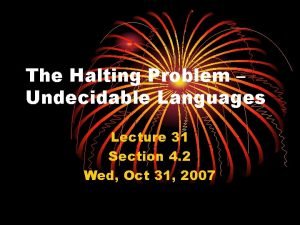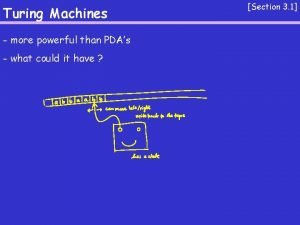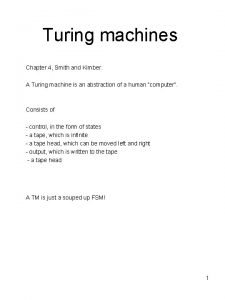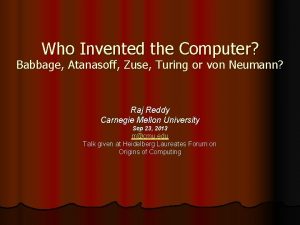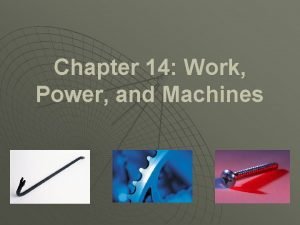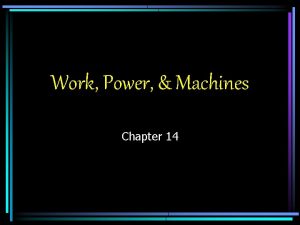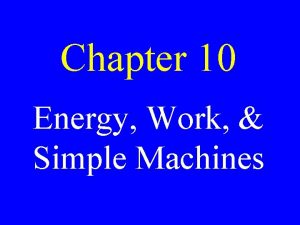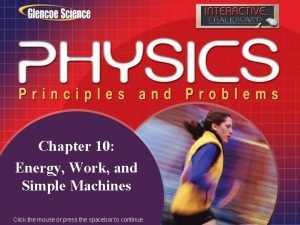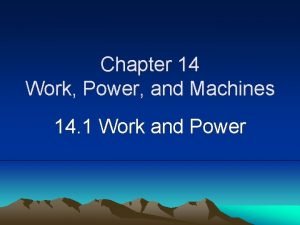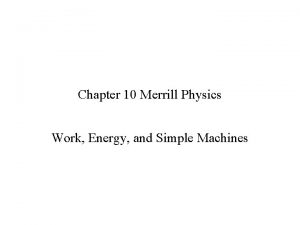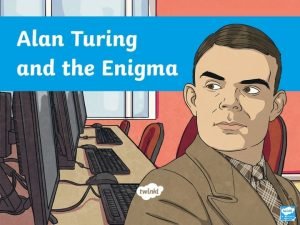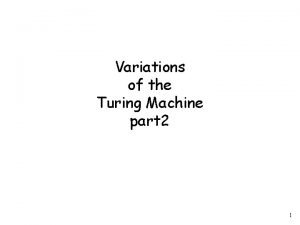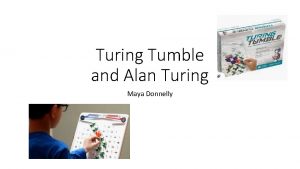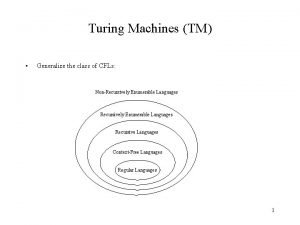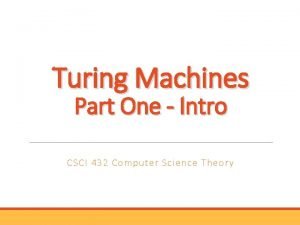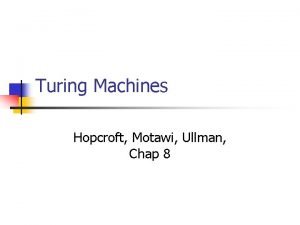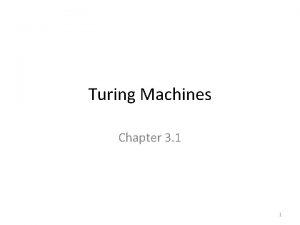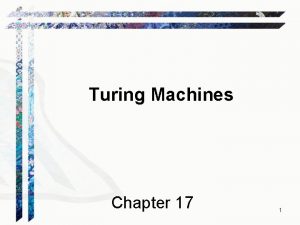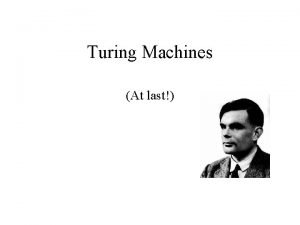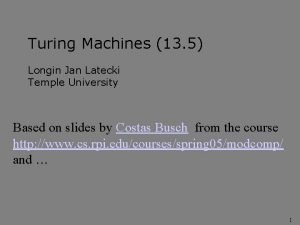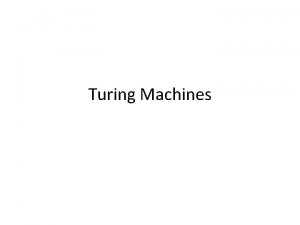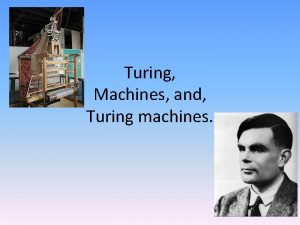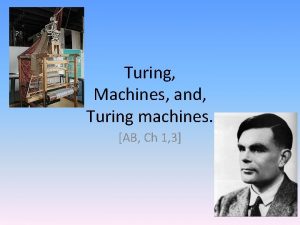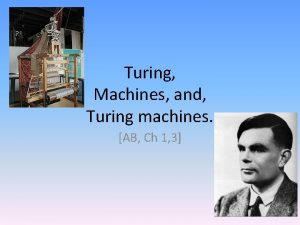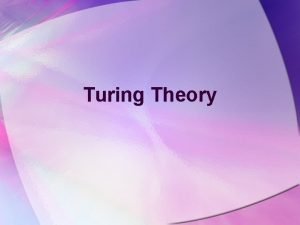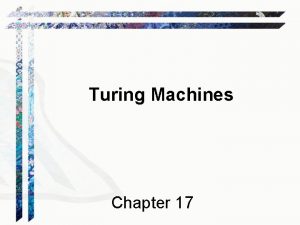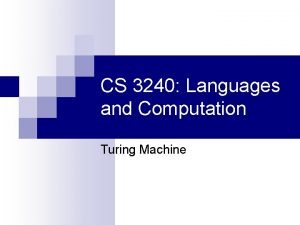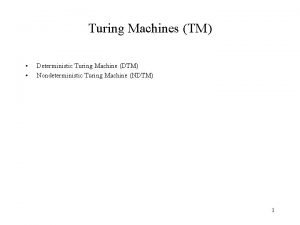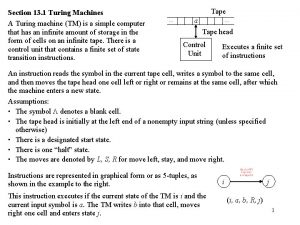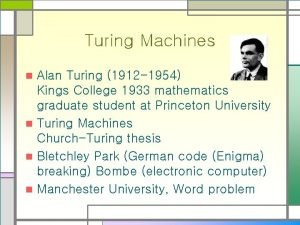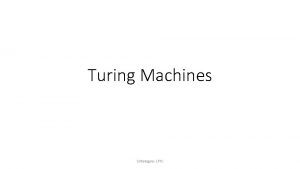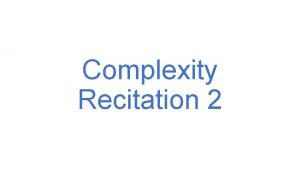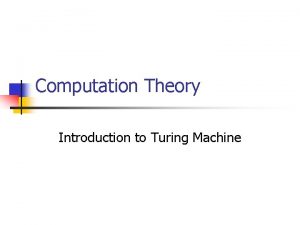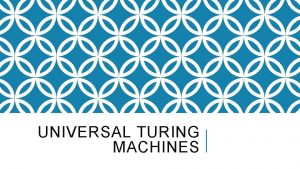Turing Machines Chapter 17 Languages and Machines SD
























- Slides: 24

Turing Machines Chapter 17

Languages and Machines SD D Context-Free Languages Regular Languages reg exps FSMs cfgs PDAs unrestricted grammars Turing Machines

Grammars, SD Languages, and Turing Machines L Unrestricted Grammar SD Language Accepts Turing Machine

Turing Machines Can we come up with a new kind of automaton that has two properties: ● powerful enough to describe all computable things unlike FSMs and PDAs. ● simple enough that we can reason formally about it like FSMs and PDAs, unlike real computers.

Turing Machines At each step, the machine must: ● choose its next state, ● write on the current square, ● move left or right. and

A Formal Definition A Turing machine M is a sixtuple (K, , s, H): ● K is a finite set of states; ● is the input alphabet, which does not contain q; ● is the tape alphabet, which must contain q and have as a subset. ● s K is the initial state; ● H K is the set of halting states; ● is the transition function: (K - H) non-halting tape state char to K state tape char { , } action (R or L)

Notes on the Definition 1. The input tape is infinite in both directions. 2. is a function, not a relation. So this is a definition for deterministic Turing machines. 3. must be defined for all state, input pairs unless the state is a halting state. 4. Turing machines do not necessarily halt (unlike FSM's and PDAs). Why? To halt, they must enter a halting state. Otherwise they loop. 5. Turing machines generate output so they can compute functions.

An Example M takes as input a string in the language: {aibj, 0 j i}, and adds b’s as required to make the number of b’s equal the number of a’s. The input to M will look like this: The output should be:

The Details K = {1, 2, 3, 4, 5, 6}, = {a, b, q, $, #}, s = 1, H = {6}, =

Notes on Programming The machine has a strong procedural feel, with one phase coming after another. There are common idioms, like scan left until you find a blank There are two common ways to scan back and forth marking things off. Often there is a final phase to fix up the output. Even a very simple machine is a nuisance to write.

Halting ●A DFSM M, on input w, is guaranteed to halt in |w| steps. ●A PDA M, on input w, is not guaranteed to halt. To see why, consider again M = But there exists an algorithm to construct an equivalent PDA M that is guaranteed to halt. A TM M, on input w, is not guaranteed to halt. And there exists no algorithm to construct one that is guaranteed to do so.

Example Configurations (1) (q, ab, b, b) (2) (q, , q, aabb) Initial configuration is (s, qw). = = (q, abbb) (q, qaabb)

Yields (q 1, w 1) |-M (q 2, w 2) iff (q 2, w 2) is derivable, via , in one step. For any TM M, let |-M* be the reflexive, transitive closure of |-M. Configuration C 1 yields configuration C 2 if: C 1 |-M* C 2. A path through M is a sequence of configurations C 0, C 1, …, Cn for some n 0 such that C 0 is the initial configuration and: C 0 |-M C 1 |-M C 2 |-M … |-M Cn. A computation by M is a path that halts. If a computation is of length n or has n steps, we write: C 0 |-Mn Cn

A Notation for Turing Machines (1) Define some basic machines ● Symbol writing machines For each x , define Mx, written just x, to be a machine that writes x. ● Head R: L: moving machines for each x , (s, x) = (h, x, ) ● Machines h, n, y, that simply halt: which simply halts. which halts and rejects. which halts and accepts.

Checking Inputs and Combining Machines Next we need to describe how to: ● Check the tape and branch based on what character we see, and ● Combine the basic machines to form larger ones. To do this, we need two forms: ● M 1 M 2 <condition> M 2

A Notation for Turing Machines, Cont'd Example: >M 1 a M 2 b M 3 ● Start in the start state of M 1. ● Compute until M 1 reaches a halt state. ● Examine the tape and take the appropriate transition. ● Start in the start state of the next machine, etc. ● Halt if any component reaches a halt state and has no place to go. ● If any component fails to halt, then the entire machine may fail to halt.

Turing Machines as Language Recognizers Convention: We will write the input on the tape as: qwq, w contains no qs The initial configuration of M will then be: (s, qw) Let M = (K, , s, {y, n}). ● M accepts a string w iff (s, qw) |-M* (y, w ) for some string w. ● M rejects a string w iff (s, qw) |-M* (n, w ) for some string w.

Turing Machines as Language Recognizers M decides a language L * iff: For any string w * it is true that: if w L then M accepts w, and if w L then M rejects w. A language L is decidable iff there is a Turing machine M that decides it. In this case, we will say that L is in D.

A Deciding Example An. Bn. Cn = {anbncn : n 0} Example: qaabbccqqqqq Example: qaaccbqqqqq

Another Deciding Example Wc. W = {wcw : w {a, b}*} Example: qabbcabbqqq Example: qacabbqqq

Semideciding a Language Let M be the input alphabet to a TM M. Let L M*. M semidecides L iff, for any string w M*: ● w L M accepts w ● w L M does not accept w. M may either: reject or fail to halt. A language L is semidecidable iff there is a Turing machine that semidecides it. We define the set SD to be the set of all semidecidable languages.

Example of Semideciding Let L = b*a(a b)* We can build M to semidecide L: 1. Loop 1. 1 Move one square to the right. If the character under the read head is an a, halt and accept. In our macro language, M is:

Example of Semideciding L = b*a(a b)*. We can also decide L: Loop: 1. 1 Move one square to the right. 1. 2 If the character under the read/write head is an a, halt and accept. 1. 3 If it is q, halt and reject. In our macro language, M is:

Why Are We Working with Our Hands Tied Behind Our Backs? Turing machines Are more powerful than any of the other formalisms we have studied so far. Turing machines Are a lot harder to work with than all the real computers we have available. Why bother? The very simplicity that makes it hard to program Turing machines makes it possible to reason formally about what they can do. If we can, once, show that anything a real computer can do can be done (albeit clumsily) on a Turing machine, then we have a way to reason about what real computers can do.
 Joan alan turing
Joan alan turing Turing unrecognizable languages
Turing unrecognizable languages Tm is more powerful than pda
Tm is more powerful than pda The turing test chapter 4
The turing test chapter 4 Chapter 4 work and energy section 1 work and machines
Chapter 4 work and energy section 1 work and machines Turing and babbage
Turing and babbage Alan turing computing machinery and intelligence
Alan turing computing machinery and intelligence Chapter 14 work power and machines
Chapter 14 work power and machines Differentiate between simple machine and compound machine
Differentiate between simple machine and compound machine Chapter 14 work power and machines
Chapter 14 work power and machines Chapter 10 energy, work and simple machines answer key
Chapter 10 energy, work and simple machines answer key Energy work and simple machines chapter 10 answers
Energy work and simple machines chapter 10 answers Chapter 14 section 1 work and power
Chapter 14 section 1 work and power Physics 10
Physics 10 Alan turing boarding school
Alan turing boarding school Multidimensional turing machine
Multidimensional turing machine Turing tumble simulator
Turing tumble simulator Halting problem of turing machine
Halting problem of turing machine Turing machine examples
Turing machine examples Turing ullman ahometz new
Turing ullman ahometz new Church turing hypothesis
Church turing hypothesis Turing machine for wcw
Turing machine for wcw Turing machine 7 tuple
Turing machine 7 tuple Arnold murray turing
Arnold murray turing Turing machine examples
Turing machine examples

